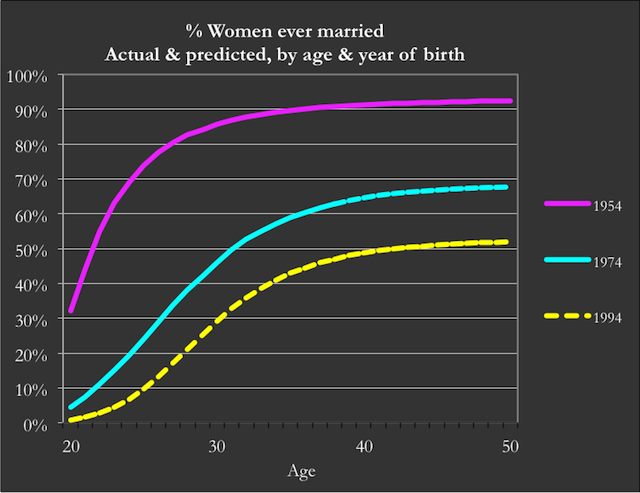Highlights
Across many social and economic trends, where America leads Britain follows. Alas, the trend away from marriage may be one area where we on this side of the pond may actually lead.
According to data from our U.K. Office for National Statistics, 92% of women and 87% of men aged sixty have been or are married. Based on my analysis of current trends, 68% of women and 62% of men aged forty have already married or will some day marry, while just 52% of today’s 20 year old men and women can expect to marry.
That’s a long way from what today’s teens actually expect to happen. My teenage daughter looked horrified when I mentioned that her odds of getting married were 50:50. “What?” she said, “Every teenage girl expects to get married.”
Well, maybe. Annual surveys from Girlguiding show that only 7% of 16–21 year old girls rule out marriage completely. A 2008 survey by the think tank Civitas found that 76% of all 20–24 year olds wanted to get married. So at least one quarter of all today's teenagers and young adults are either going to be disappointed or will have to change their expectations.
Other than adding to the sum of teenage angst, does any of this matter? Undoubtedly. If you want couples to stay together and their families to thrive, then marriage matters. And there are lots of reasons to want couples and families to do exactly that.
At an individual level, family breakdown sucks. Just one of the many effects is the greater likelihood of teenage problem behavior. A recent major report from our Department for Education found that being in a lone parent family had a “small” unique effect on teenage behavior compared to being in a married family. Don’t be fooled by the word ‘small’ here. This effect appeared even after controlling for the kind of protective relational factors that many would argue are integral to—and correlate with—marriage. Having removed most of the ingredients, it's astonishing to find any cake left at all. In other words, “small” was the most conservative finding possible.
At a political level, family breakdown costs the U.K. taxpayer $76 billion per year. That’s more than we spend on defense and about half of what we spend on education. More than half of this is spent on welfare payments. Housing benefit, for example, is paid to 63% of single parents compared to 10% of coupled parents. The collapse of income among single parents is reason alone to be concerned about family breakdown.
Why marriage? The simple fact is that few couples make it through bringing up their kids without getting married along the way. My analysis of data from Britain’s largest panel survey, Understanding Society, shows that out of the 55% of parents of 13–15 year olds who have remained together, 51% are married. The other 4% are all that's left of the 26% of births to unmarried couples fifteen years earlier. The rest either split or married. Long-term stable relationships outside of marriage are very much the exception.
Where does this leave today’s teenagers? The net result of ever fewer marriages will be even more family breakdown and even fewer couples.
The United Kingdom has no policy whatsoever on any of these trends, largely treating marriage with indifference and family breakdown as inevitable. I suspect it won't be the direct costs that make politicians—of any party—finally begin to ask whether some proportion of family breakdown might possibly be avoidable. It will be the indirect effects that get their attention, maybe the realization that ever more fragmented families puts huge pressure on housing demand, or that fewer couples means less private social capacity to look after the elderly and infirm and therefore more demand for public social care.
It's easy to become pessimistic about all this. More relationships are going to fail. More families are going to suffer. The state is going to pick up an ever-bigger bill. But for naive optimists like me, there may be the first small ray of hope. The most recent UK marriage rates—for 2011—shot up by 5%. The cause was almost certainly a ripple effect from the Royal wedding the previous year. On its own, this blip makes little difference to the overall trend and may well turn out to be no more than a one-off event in any case.
But what it confirms is that social forces can influence private behavior on marriage. Maybe, just maybe, things can get better after all.












